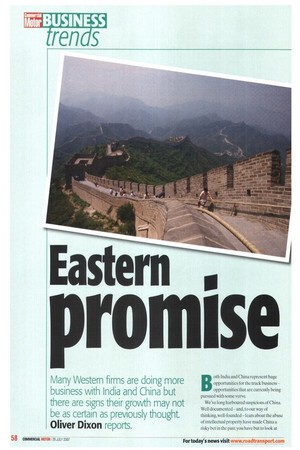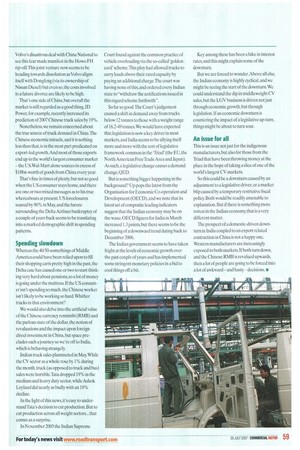Eastern •
Page 58

Page 59

If you've noticed an error in this article please click here to report it so we can fix it.
140111rSe
Many Western firms are doing more business with India and China but there are signs their growth may not be as certain as previously thought. Oliver Dixon reports.
Both India and China represent huge opportunities for the truck business — opportunities that are currently being pursued with some verve.
We've long harboured suspicions of China. Well documented — and, to our way of thinking, well-founded —fears about the abuse of intellectual property have made China a risky bet in the past; you have but to look at Volvo's disastrous deal with China National to see this fear made manifest in the Howo FH rip-off This joint venture now seems lobe heading towards dissolution as Volvo aligns itself with Dongfeng (via its ownership of Nissan Diesel) but even so, the costs involved in a future divorce are likely to be high.
That's one side of China, but overall the market is still regarded as a good thing.JD Power, for example, recently increased its prediction of 2007 Chinese truck sales by 19%.
Nonetheless, we remain concerned about the true source of truck demand in China.The Chinese economic miracle, and it is nothing less than that, is in the most part predicated on export-led growth. And most of those exports end up in the. world's largest consumer market — the US. Wal-Mart alone sources in excess of $18bn-worth of goods from China every year.
That's fine in times of plenty, but not so good when the US consumer stays home, and there are one or two mixed messages as to his true whereabouts at present. US foreclosures soared by 90% in May, and the furore surrounding the Delta Airlines bankruptcy of a couple of years back seems to be translating into a marked demographic shift in spending patterns.
Spending slowdown
Whereas the 40/50-somethings of Middle America could have been relied upon to fill their shopping carts pretty high in the past, the Delta case has caused one or two to start thinking very hard about pensicins,so a lot of money is going under the mattress. If the US consumer isn't spending so much, the Chinese worker isn't likely to be working so hard. Whither trucks in that environment?
We would also delve into the artificial value of the Chinese currency renminbi (RMB) and the parlous state of the dollar, the notion of revaluations and the impact upon foreign direct investment in China, but space precludes such a journey so we're off to India, which is behaving strangely.
Indian truck sales plummeted in May. While the CV sector as a whole rose by 1% during the month, truck (as opposed to truck and bus) sales were horrible.Tata dropped 19% in the medium and heavy duty sector,while Ashok Leyland did nearly as badly with an 18% decline.
In the light of this news, it's easy to understandTata's decision to cut production. But to cut production across all weight sectors... that comes as a surprise.
In November 2005 the Indian Supreme Court found against the common practice of vehicle overloading via the so-called 'goldencard' scheme.This ploy had allowed trucks to carry loads above their rated capacity by paying an additional charge.The court was having none of this, and ordered every Indian state to "withdraw the notifications issued in this regard scheme forthwith".
So far so good.The Court's judgement caused a shift in demand away from trucks below 12 tonnes to those with a weight range of 16.2-49 tonnes. We would have expected this legislation is now a key driver in most markets, and India seems to be allying itself more and more with the sort of legislative framework common in the 'Triad' (the EU, the North American FreeTrade Area and Japan). As such, a legislative change causes a demand change, QED.
But is something bigger happening in the background? Up pops the latest from the Organisation for Economic Co-operation and Development (OECD), and we note that its latest set of composite leading indicators suggest that the Indian economy may be on the wane. OECD figures for India in March increased 1.3 points, but there seems to be the beginning of a downward trend dating back to December 2006.
The Indian government seems to have taken fright at the levels of economic growth over the past couple of years and has implemented some stringent monetary policies in a bid to cool things off a bit. Key among these has been a hike in interest rates, and this might explain some of the downturn.
But we are forced to wonder. Above all else, the Indian economy is highly cyclical, and we might be seeing the start of the downturn. We could understand the dip in middleweight CV sales, but the LG V business is driven not just through economic growth, but through legislation. If an economic downturn is countering the impact of a legislative up-turn, things might be about to turn sour.
An issue for all
This is an issue not just for the indigenous manufacturers, but also for those from the Triad that have been throwing money at the place in the hope of taking a slice of one of the world's largest CV markets.
So this could be a downturn caused by an adjustment to a legislative driver, or a market blip caused by a temporary restrictive fiscal policy Both would be readily amenable to explanation. But if there is something more rotten in the Indian economy, that is a very different matter.
The prospect of a domestic-driven downturn in India coupled to an export related contraction in China is not a happy one. Western manufacturers are increasingly exposed to both markets. If both turn down, and the Chinese RMB is revalued upwards, then a lot of people are going to be forced into a lot of awkward— and hasty decisions..
























































































































































































